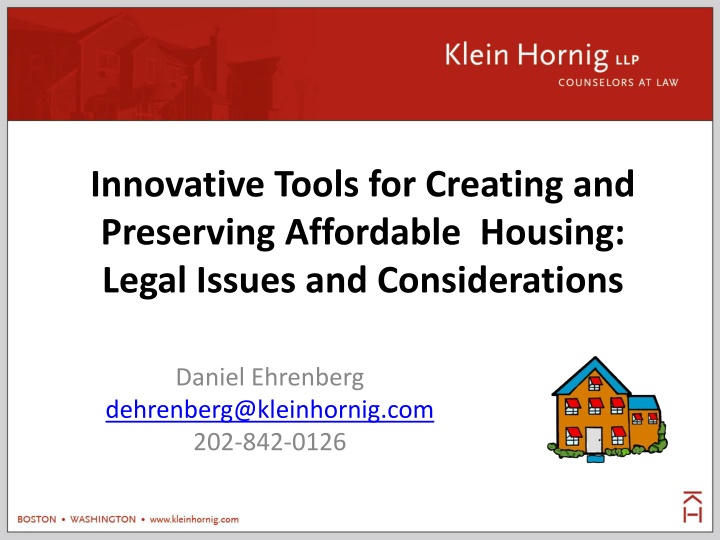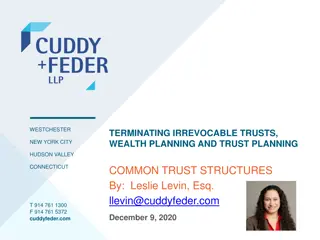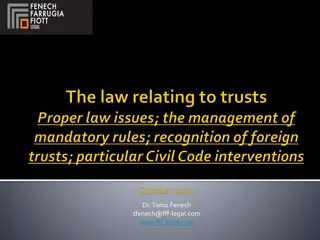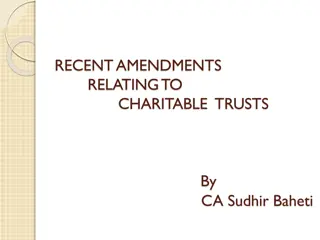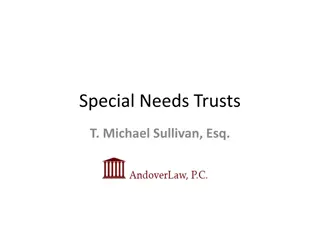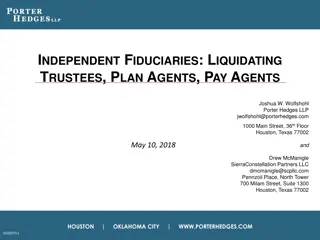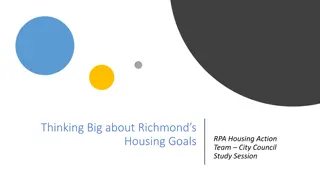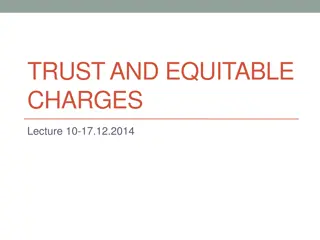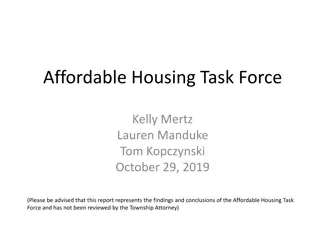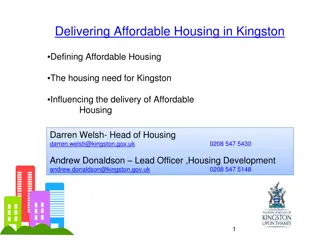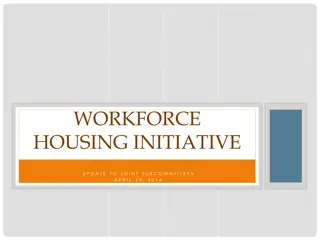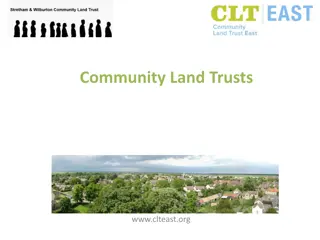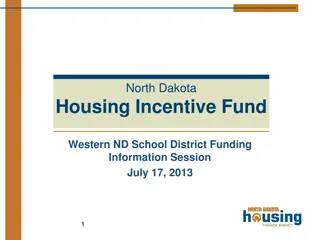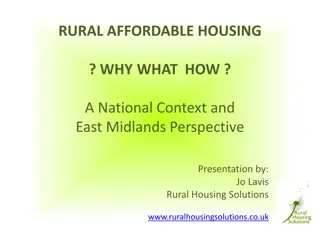Legal Considerations for Affordable Housing Land Trusts
Explore legal issues and regulations surrounding Community Land Trusts in DC, Virginia, and Maryland. Learn about the implications of ground leases, ownership rights, and separation of land and improvements in affordable housing initiatives. Discover the responsibilities and restrictions imposed on homeowners and CLTs to ensure long-term affordability and sustainability.
Download Presentation

Please find below an Image/Link to download the presentation.
The content on the website is provided AS IS for your information and personal use only. It may not be sold, licensed, or shared on other websites without obtaining consent from the author.If you encounter any issues during the download, it is possible that the publisher has removed the file from their server.
You are allowed to download the files provided on this website for personal or commercial use, subject to the condition that they are used lawfully. All files are the property of their respective owners.
The content on the website is provided AS IS for your information and personal use only. It may not be sold, licensed, or shared on other websites without obtaining consent from the author.
E N D
Presentation Transcript
Innovative Tools for Creating and Preserving Affordable Housing: Legal Issues and Considerations Daniel Ehrenberg dehrenberg@kleinhornig.com 202-842-0126
DC & Virginia Laws and Regulations on Community Land Trusts District of Columbia No Laws or Restrictions on CLTs In 2007, DC supported a Workforce Housing Land Trust Design and Implementation Plan What is now City First Homes Virginia No Laws or Restrictions on CLTs Defines a CLT in 2 places in the Virginia Code, as a not-for-profit, community organization, controlled by a membership board that acquires land for perpetuity, transferred per long-term ground leases, transfers the improvements on such land to tenants and has a preemptive purchase option on the improvements at a formulaic price designed to keep the improvements affordable. However, Definition only used to exclude CLT from definition of Landlord for Landlord-Tenant law purposes 2
Maryland Laws and Regulations on Community Land Trusts Due to an unfavorable history of ground leases going back to the days of Lord Baltimore and Lord Calvert, Maryland has created an entire regime of regulating the creation and operation of Affordable Housing Land Trusts as either a Non-Profit or a State Government Entity An AHLT needs to register as such with SDAT An AHLT must use an Affordable Housing Land Trust Agreement so as to not be subject to Laws concerning Ground Leases, especially the right of tenant to redeem such Ground Leases to convert to Fee Simple Ownership MD s law is called the Affordable Housing Land Trust Act, 14-501 et seq. of Real Property Code of Maryland. 3
What does the Ground Lease do? The 99 year ground lease ties the improvements and the land together: Ensures that the house and land is inheritable Outlines rights and responsibilities of the homeowner and the CLT (i.e., upkeep, mortgage and CLT fee payments) Establishes use restrictions (i.e., residency, sales price) Establishes affordability restrictions (i.e., maximum income of initial occupants) 4
Issues with Separating Land from Improvements How does One separate the Land from the Improvements and the Improvements from Personal Property? Who owns and gets to keep what at end of lease and what can be removed from the Land? Most CLTs require the homeowner to obtain the CLT s prior consent to make Improvements. (CLT does not want home to become too expensive for the next homeowner.) What constitutes maintenance or repairs of existing Improvements v. a new or added Improvement? Is the Land taxed separately from the Improvements? Who pays the tax? How is the Property assessed with a resale- restricted price? Most CLTs require the homeowner pay the entire tax for the land and improvements. Who is liable for anything that occurs on the property? Who pays for insurance? Most CLTS make the homeowner responsible for insurance. All of these issues need to be addressed in the Ground Lease. 5
Issues with Separating Land from Improvements How does One separate the Land from the Improvements and the Improvements from Personal Property? Who owns and gets to keep what at end of lease and what can be removed from the Land? Most CLTs require the homeowner to obtain the CLT s prior consent to make Improvements. (CLT does not want home to become too expensive for the next homeowner.) What constitutes maintenance or repairs of existing Improvements v. a new or added Improvement? Is the Land taxed separately from the Improvements? Who pays the tax? How is the Property assessed with a resale- restricted price? Most CLTs require the homeowner pay the entire tax for the land and improvements. Who is liable for anything that occurs on the property? Who pays for insurance? Most CLTS make the homeowner responsible for insurance. All of these issues need to be addressed in the Ground Lease. 6
Using Restrictive Covenants instead Ground Leases Advantages of Restrictive Covenants: Avoid land acquisition challenges Avoid perceptions of homeowner as 2nd class citizen Better known and create greater security for financing by Banks Disadvantages of Restrictive Covenants: Enforceability is less tested May violate Rule against Perpetuities or Rule against Restraints on Alienation no end date Less skin in the game by CLT since it does not own the Land CLT has less proximate interest in home, no leased fee Less Incentive for Stewardship and to know early if problems arise 7
How do you make (and keep) the property affordable? Initial Long-Term Investment (Subsidy) Subsidize the cost of acquisition or construction Help the homebuyer purchase an existing home All of the initial long-term investment is retained and recycled in the home Resale formula requires that the home be sold at a price that is affordable for other low- income families 8
Affordability v. Equity Traditional Subsidized Homeownership Community Land Trust Home Affordable Rental Unit Initially affordable Not affordable at resale All equity for owners Initially affordable Affordable at resale Some equity for owners Permanently affordable No equity for renters 9
Whats the Role of the CLT? The CLT is an active steward of the property: Preserve affordability Preserve quality Protect security As a steward, the CLT works with the homeowner during the purchase, occupancy, and resale 10
What are the key parts of active stewardship? 1. Initial and ongoing education 2. Approving actions of the homeowner 3. Monitoring actions of the homeowner 4. Enforcing obligations of the homeowner 5. Supporting the homeowner 11
Key Steps in Forming a CLT Find a champion Develop a business plan and financial model Draft the ground lease Find houses Find & educate potential buyers 12
Resources Klein Hornig LLP Grounded Solutions Network http://groundedsolutions.org/ Provides technical assistance and other support to CLTs throughout the country. Contact: Jason Webb (focuses on start up CLTs) jwebb@groundedsolutions.org Start-Up CLT Hub: http://groundedsolutions.org/start-upclthub/ CLT Technical Manual: http://groundedsolutions.org/resources/#manual Habitat Report on Permanent Affordability: https://www.habitat.org/about/advocacy/resources/shelter- report 13
